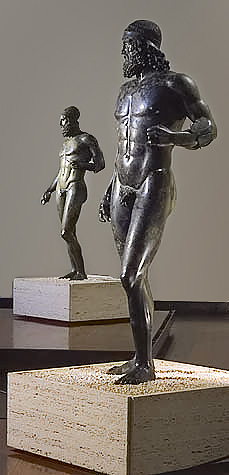Facts About Riace bronzes
The Riace Bronzes, also known as the Riace Warriors, are two exquisite full-sized Greek bronze statues of bearded warriors. Discovered off the coast near Riace in 1972, they date back to around 460–450 BC. Today, these masterpieces can be admired at the Museo Nazionale della Magna Grecia in Reggio Calabria, Italy. Among the few surviving examples of ancient Greek bronze sculpture, these statues vividly showcase the exceptional skill and artistry of that era.
Their discovery was quite serendipitous. A chemist named Stefano Mariottini stumbled upon them while snorkeling near Monasterace. The bronzes were not fully recovered until 1981. Their public display in Florence and Rome that same year generated considerable excitement and cultural interest across Italy. Known as Statue A and Statue B, they depict two warriors: one younger and one more mature.
There is some debate about their origins. Many scholars believe they were crafted by two different Greek artists in the 5th century BC. These bronzes mark a significant transition from the archaic style of Greek sculpture to the early Classical style, evident in their realistic features and dynamic contrapposto poses. After being moved to the Palazzo Campanella for restoration, their refurbishment was completed in 2011.
The identities of these warriors remain a mystery. Some suggest they could be Tydeus and Amphiaraus, while others propose they might be Athenian warriors from Delphi or Olympia. Regardless of their true identities, these bronzes are considered original, high-quality works. It is believed that their torsos were modeled on a single template before being individually cast.
Researchers continue to explore the history and origins of the Riace Bronzes. Various theories have attributed them to renowned sculptors, and it is possible they were once part of a votive group in a sanctuary. Their artistry and significance have made them symbols of Calabria, inspiring ongoing studies and discussions in the field of ancient art.
The Riace Bronzes have been the subject of numerous publications and documentaries, underscoring their cultural and artistic importance. They continue to captivate scholars and art enthusiasts, standing as a testament to the brilliance of ancient Greek sculpture.

 Vatican
Vatican